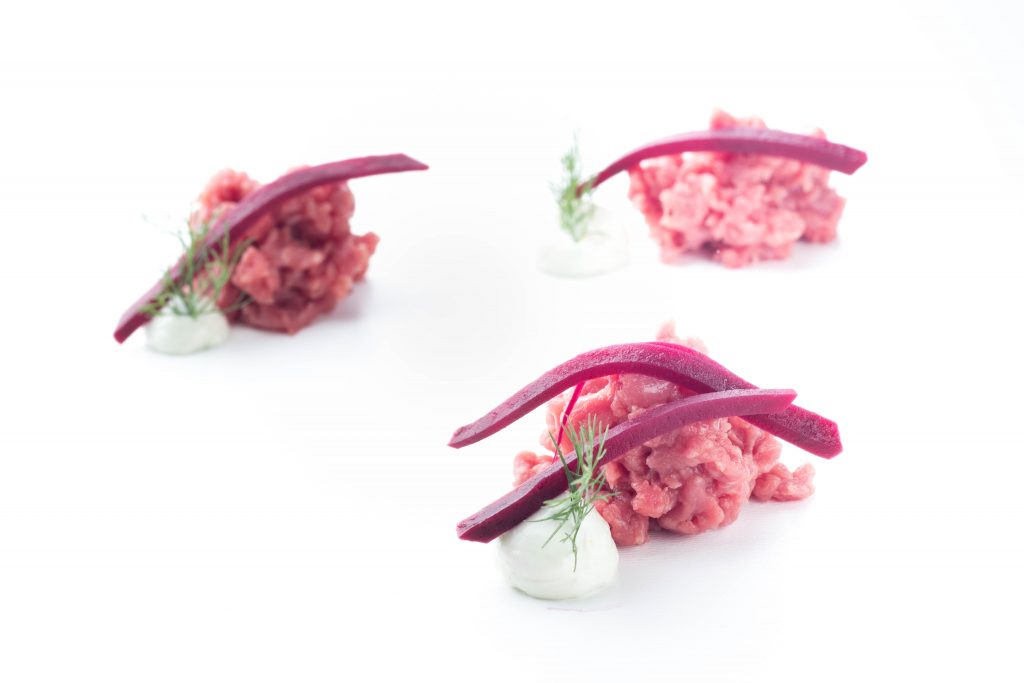Blog
A trip in the world of catering
The hand-cut steak tartare is a real must for meat lovers. Easy and quick to prepare,
this French dish is known for its very tender and lean cut, which makes it ideal to be eaten raw. To prepare this dish use beef shoulder. This cut does not stand out for its tenderness and is even considered a “poor” cut due to being rich in connective tissue, which does not make it one the most appropriate meats for this kind of preparation. Indeed, the shoulder is traditionally used to prepare braised or boiled meat with long cooking times, which melt the connective tissues, turning the meat cut into a more tender and tastier dish, but also cause a significant loss of weight and a loss of the nutritional properties during cooking.
Using waveco® and its ground-breaking technology of induced maturation©, you can melt the shoulder connective tissues without cooking, thus safeguarding all the organoleptic properties and obtaining an extremely tender cut, ideal for the preparation of your tartare. Below you can find a raw food recipe, which puts into practice the technique used by waveco®: “Steak tartare with fermented red turnip and lime mayonnaise”. For this recipe, use a shoulder of beef, one red turnip, eggs, lemon and lime.
BEEF SHOULDER
The meat cut is bought from the supply chain 48 hours after being slaughtered. Before the 60-minute induced maturation® process, the whole shoulder is divided into 3 pieces and put into containers of about 1 kg each. The result of the process with waveco® is an uncooked meat which has maintained its nutritional properties and has not experienced a loss of weight. In addition, its ground-breaking technology has melted the connective tissue, making the meat tender and succulent. A result which cannot be obtained without waveco®, even when using the long ageing technique.
TECHNICAL FOCUS: AGEING
This is a chemical-physical process which makes meat more tender and tastier, depending on its duration and storage techniques. However, this process also presents negative aspects, such as a loss of weight, a loss of nutritional properties and an advanced stage of deterioration. The economic aspect shall not be underestimated too: as the number of ageing days increases, the cost of the meat increases as well.
TARTARE PREPARATION
After induced maturation©, meat is removed from containers, cut into smaller pieces and hand-cut. The result is a tartare with a bright colour and an almost creamy consistency, which gives the meat an outstanding tenderness, only achievable through waveco®.
TECHNICAL FOCUS: STEAK TARTARE
This technique allows the raw meat to be thinly cut without “tearing” the fibres and most importantly without warming it up, so that juices are not lost, and the nutritional properties remain unchanged. However, be careful not to cause contamination: the first rule is to avoid using knives already used with other foods (raw or cooked) and to work on sanitised surfaces only.
RED TURNIP FERMENTATION
Once washed, peeled and cut into julienne strips, the red turnip is put into the container in an acetic solution and prepared with the induced maturation© process, which tenderises meat and achieves great advantages in terms of fermentation in a short time (about 60 minutes): thanks to waveco®, you can accelerate the process, which takes place in complete safety and lets us use the turnip in the recipe after only three days of fermentation in the fridge. Achieving a similar result with the traditional techniques in such a short time is completely impossible: generally, the tenderness of the turnip can be increased only with several hours of boiling with the skin on, while fermentation requires several days of rest, with the risk that the food might produce bacteria harmful to human health.

TECHNICAL FOCUS: FERMENTATION
This technique of ancient origins allows the food taste and consistency to be transformed, in addition to extending its shelf life. The process can be easily repeated if the following rules are carefully followed. The food, properly cleaned and washed, must be put into containers and covered with a liquid solution characterized by an acid and a sugared part. For the fermentation process to start, let the food rest in an environment at about 20°C for about 10-15 days.
LIME MAYONNAISE
Put the oil and the egg white into the container and start the induced maturation® process for 20 minutes; once finished, you will have a stable emulsion with the proper consistency. Pour the content into a bowl, add lime juice, lemon skin and salt and beat the mixture. Thanks to waveco®, you can obtain a high-quality product, always replicable, which will never need to be “adjusted” with stabilisers or thickeners to keep together the watery and the fat part of the foods.
TECHNICAL FOCUS: HOMOGENISATION
Homogenisation is aimed at making uniform a mixture of immiscible substances, such as: oil (fat substances) in water. The emulsions obtained “break/separate” very easily. They are very delicate structures, whose stability can be influenced by temperature, dissolved salts, shaking and many other factors. To avoid these problems, molecules like emulsifiers or surfactants are used as they contain elements which are both similar to water and to fats and thus make the mixture stable.
PLATING
Lay on a plate three small quenelles of the same dimensions as the beef shoulder tartare, add the mayonnaise, using a piping bag to help, and finally the slices of fermented turnip. If you want, simmer with fresh vinegar until reduced.
CHEF FOCUS
With induced maturation©, preparing a hand-cut steak shoulder tartare is incredibly easy; you will have a tender meat which is pleasant to chew. The colour is simply amazing: a bright red without oxidation which indicates a significant increase in the shelf life. As for the mayonnaise, waveco® allows to achieve a stable homogenisation which does not lose its consistency and is not at risk of curdling, even after beating by hand.